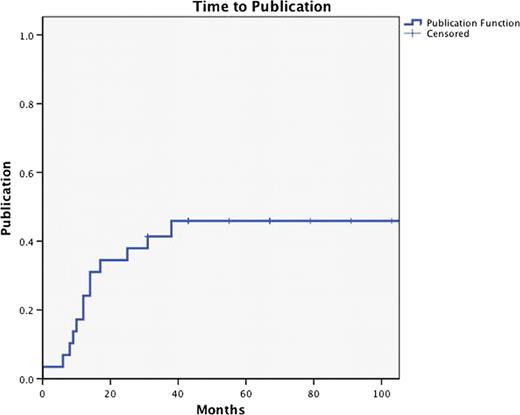Abstract
Abstract 3816
The timely publication of cancer cost-effectiveness analyses (CEA) is essential to inform decisions regarding new drug adoption by relevant policy makers and stakeholders. This study examined the publication pattern and quality of CEA presented in the annual meetings of the American Society of Hematology (ASH).
ASH abstracts from 1997 to 2007 were reviewed. Abstracts with a malignant focus and that reported primary outcomes of incremental cost per life-year-gained or quality-adjusted-life-year (QALY) were included. Data including ICER (adjusted to USD) and author affiliation to the pharmaceutical industry was extracted. Quality indicators associated with well-performed CEAs were derived from the literature (Weinstein MC et al., JAMA 1996;276:1253-1258) and used to determine abstract quality. A search for subsequent publication of the abstract findings was conducted using Medline. The primary outcome of time-to-publication was determined using Kaplan-Meier statistics. Predictor variables were tested using the log-rank statistic.
29 abstracts met inclusion criteria. Only 13 were published (overall rate of 44.8%). The actuarial 1 and 3 year publication rates were 24.1% and 41.4% respectively (see figure). All but 1 abstract presented at ASH had an ICER less than $100 000/QALY (median $33 000/QALY) with 55.2% disclosing author affiliation to the pharmaceutical industry. Specific to abstracts published after 2001, when ASH instituted a policy of disclosure reporting, the proportion of abstracts reporting pharmaceutical affiliation was 72.7%. No variable or quality indicator predicted for time-to-publication though there was a trend for abstracts reporting dominant ICERs to yield more timely publications (p = 0.075). In terms of quality indicators, the reporting of a societal perspective, lifetime horizon, or a sensitivity analysis was noted in only 37.9%, 24.1% and 62.1% of abstracts, respectively.
The publication rate of CEA abstracts from ASH was low and not timely for open discussion among stakeholders. Although there was no direct evidence of bias in abstracts selected for presentation, most reported highly favorable ICERs and consistent author affiliation with the pharmaceutical industry. Overall, the quality of abstracts appeared suboptimal.
No relevant conflicts of interest to declare.
Author notes
Asterisk with author names denotes non-ASH members.


